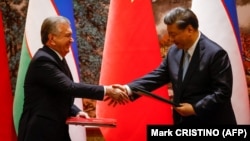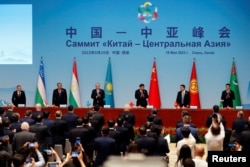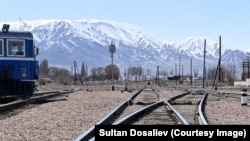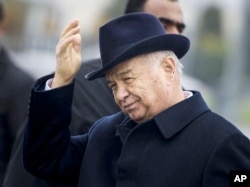Uzbek President Shavkat Mirziyoev is in Beijing to meet with Chinese leader Xi Jinping for a high-profile state visit intended to lay the groundwork for strong ties between the two countries.
In an article signed by Mirziyoev that appeared in Chinese state media ahead of the trip, the Uzbek leader praised China’s model of economic development and said relations between the two countries are experiencing “new historical heights” that will allow him to use the January 23-25 trip to “develop a new long-term agenda” for the two countries that will last for “decades.”
"Every time I visit China, I sincerely admire the scale of the reforms taking place here, the accomplishments, creative strength, diligence, and talent of the Chinese people who are confidently pursuing the path of modernization to realize their centuries-old dream,” the article said.
The state visit comes following the first in-person China-Central Asia leaders’ summit in May where China inked several agreements to deepen its economic and security links with the region. In Beijing, Mirziyoev is looking to build upon those deals as well as a comprehensive strategic-partnership agreement signed in 2022.
While meeting with Xi and other top-level Chinese officials, the Uzbek delegation will look to court investment and agree with their counterparts on how to bring many previously signed deals to fruition, from developing green energy projects to cooperation in science and boosting tourism between China and Uzbekistan.
“This is less about concrete outcomes and more about setting a road map for the future,” Niva Yau, a fellow at the Atlantic Council's Global China Hub, told RFE/RL. “China has committed to investments and projects and this high-level visit is [about] how to achieve them and to search for new areas to cooperate together.”
Evolving Ties
The visit takes place against the backdrop of several major developments that have changed the political environment at home and abroad for Uzbekistan’s relationship with China.
Russia’s 2022 full-scale invasion of Ukraine has boosted China’s standing as a reliable political and economic force for the countries of Central Asia as Moscow -- the region’s traditional dominant partner -- has grappled with financial and geopolitical fallout from the conflict.
After a decade of infrastructure investments around the globe through Beijing’s multibillion-dollar Belt and Road Initiative (BRI), China wants to use the project to invest in new sectors and become a more strategic lender after facing criticism for a lack of transparency in BRI loans as it now grapples with a slowing domestic economy.
Facing such headwinds, China is looking to make the BRI smaller and greener through more risk-averse loans and investments in renewables, and Yau said this could factor into the results from Mirziyoev’s visit.
China, she notes, has been investing heavily in environmental and scientific research and monitoring, with several notable investments in Central Asia.
Tajikistan, which neighbors Uzbekistan to the southeast and shares a border with China, opened a Chinese observation station on Lake Sarez in 2021, reportedly for environmental research and “international disaster reduction and prevention,” according to the Chinese Academy of Sciences.
In July 2023, Chinese researchers also unveiled a new “super” observation post for climate and environmental monitoring in Shahritus, near the meeting point of China's borders with Uzbekistan and Afghanistan.
The stations have scientific and technological applications, but observers note the installations are part of a broad network of similar stations across BRI countries in South and Central Asia that could have dual applications for security and surveillance.
Beijing has also looked to expand the list of countries cooperating with its space program, reaching an agreement with Turkmenistan in 2023.
While traditional Chinese investments in Central Asia are still in play, such as a proposed natural gas pipeline from Turkmenistan to China and a railway connecting China to Kyrgyzstan and Uzbekistan, their futures are uncertain.
Yau said Beijing is looking to bring these new areas of investment and industry that it has expanded elsewhere in the world to Central Asia, and Uzbekistan, with a population of some 35 million, is an attractive partner.
One particular sector of interest is renewable energy and opening up new markets for Chinese electric vehicles.
China has been positioning itself as a market leader around the world for years and, in December, China’s Henan Suda signed a deal with the Uzbek Energy Ministry to build some 50,000 charging stations for electric vehicles around the country by 2033.
“These are areas where China is becoming a global leader and it wants to bring them to Central Asia,” Yau said.
New President, New Era
While events like the war in Ukraine have affected the relative appeal of Beijing and Moscow as partners for Central Asia, Mirziyoev’s high-profile visit is the product of years of warming ties between China and Uzbekistan, says Temur Umarov, a fellow at the Carnegie Russia-Eurasia Center in Berlin.
“This direction towards China has been Mirziyoev’s priority from the beginning,” he told RFE/RL. “Mirziyoev is very interested in China and often quotes [former Chinese leader] Deng Xiaoping in his speeches; and he clearly sees the country as an example for how to develop economically.”
China’s experience combating top-level corruption under Xi and its efforts to lift millions out of poverty, Umarov says, have been a particular focus for the Uzbek leader since he came to power in 2016 following the death of Islam Karimov, the country’s first ruler after the collapse of the Soviet Union in 1991.
“China has become a source of knowledge in a way for Mirziyoev,” Umarov said. “Given that Uzbekistan is a personalistic regime, how he sees China matters a lot.”
Uzbekistan followed a far more isolationist foreign policy under Karimov that was suspicious of outside influence.
China was still an important partner, with Chinese leader Hu Jintao inviting Karimov to Beijing for a visit in 2005 less than two weeks after the bloody crackdown against protesters in the northeastern Uzbek city of Andijon, though the relationship was limited. Under the hard-line Karimov regime, Chinese companies and capital in many sectors of the economy were restricted.
That changed following Karimov’s death, which brought Mirziyoev to power.
As the new Uzbek president has opened up his country’s economy, China has been both a reliable source of investment and a valuable ally that has helped Mirziyoev build his legitimacy at home and abroad.
As Umarov notes, China’s own model of opening its economy while retaining tight political control is one that looks increasingly appealing to Mirziyoev.
“This is very relevant to him as he tries to build his own political regime based on Karimov's heritage,” Umarov said. “He knows that he needs to adapt to the world and learn from similar regimes about how to navigate the complex realities of today.”





